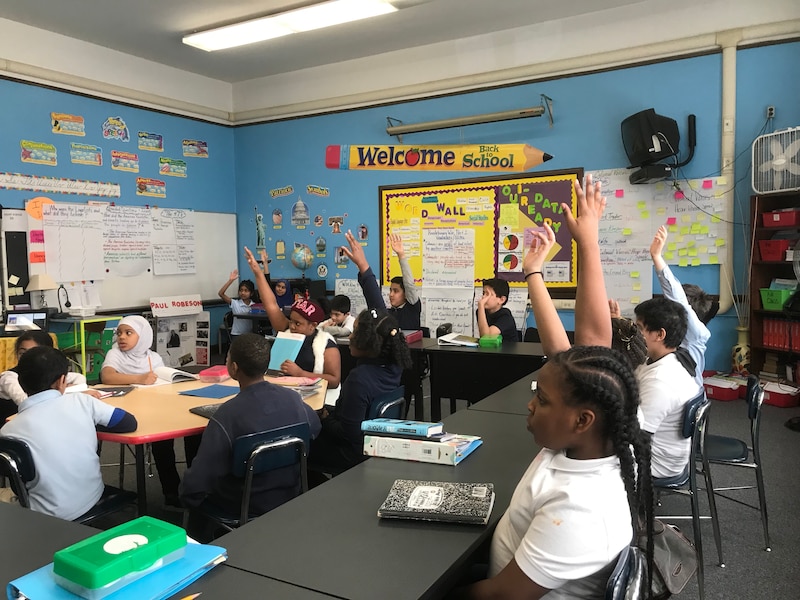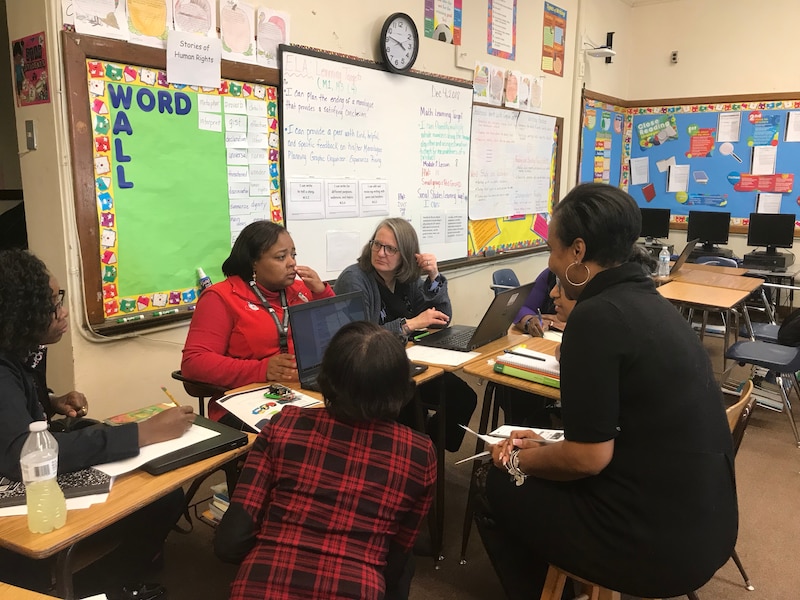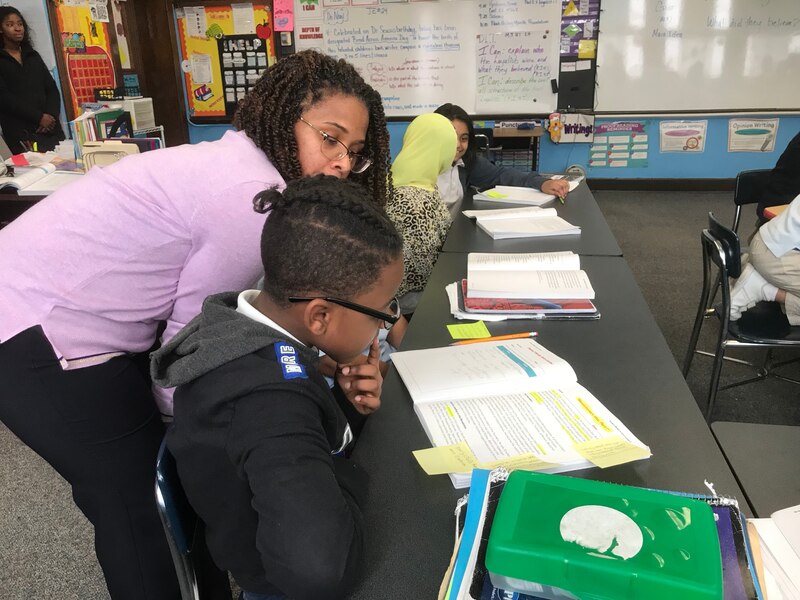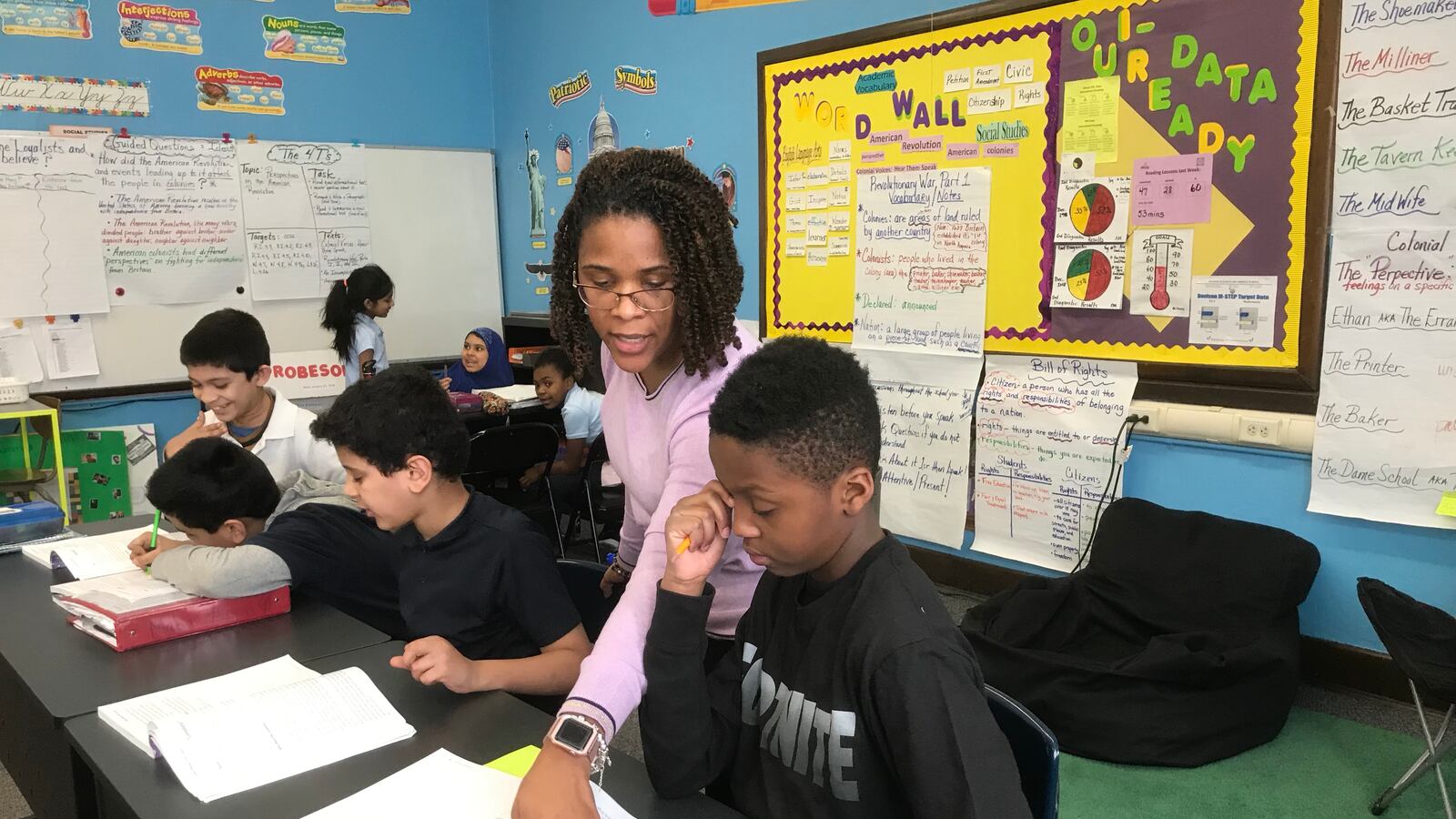Kenya Posey has taught the American Revolution before, but never before has her lesson on this moment in history looked like it did on this day.
There was the animated Otto Brumit, who literally squirmed in his seat at Davison Elementary-Middle School as he begged his teacher to pick him to answer a question. There was the team of Aniyah Paige and Kayleigh Nixon, who insisted on being the first to describe the loyalists and their beliefs to the class. So many students, in fact, wanted to share their knowledge that Posey frequently had to remind them they were running short on time.
It’s the kind of engagement Detroit school district leaders had in mind when they adopted a demanding new K-8 curriculum for English language arts and math. The district is more than halfway through the first year of that ambitious reboot, replacing what was deemed inferior with what they say better represents what students should learn in order be successful in life — and pass state exams.
For Posey, getting kids so deeply involved in her class last week takes a lot of hard work.
“It’s kind of like you’re going back to school,” said Posey, a 15-year veteran teacher. Still, despite all the extra work, “It was time for a new curriculum,” she said.

But the new curriculum comes with some major growing pains for teachers. Adjusting to two new curriculums in one school year has been challenging for teachers who say it’s requiring far more time, far more activities, much more preparation, and a different approach to teaching. And, it’s rigorous, which some teachers say is difficult in a district with so many students who are behind academically.
A lot is riding on the success of this effort. The district has had the worst results among big-city school districts on a rigorous national exam every year since it’s been administered in the last decade. District students also struggle on state exams. It’s a situation that wasn’t helped by nearly two decades of state-controlled emergency management, when leaders were focused on the district’s massive debt, and not so much on academic improvement. This effort is a crucial piece of the district’s transformation now that it’s been under local control for the last two years.
Chalkbeat sought insight from hundreds of teachers in the district in an attempt to gauge how they and their students are adjusting to the new K-8 curriculum. In all, we talked to about 10 teachers from across the district.
At a number of schools, teachers are coming together weekly after school to get help with the new curriculum during study sessions. Here, they can vent, share ideas and motivate each other. It can be a frank discussion, as was the case recently at Davison when nearly a dozen teachers attended the Tuesday session.

“At the end of the day it’s all about the children and how we can help raise achievement of all students,” said Shelly White, a fifth-grade teacher at Davison. She and Dorrine Griffin, an eighth-grade teacher, are the master teachers who lead the English language arts study sessions. Master teachers in the district spend half their time teaching, and the rest coaching their peers.
The sessions usually begin with a teacher sharing an experience. During a session weeks ago, some of that sharing came from a veteran teacher who said she’s been through many curriculum adoptions.
“I know we’ve been down a lot … and we feel like new teachers this year, even though we’ve been doing it for many, many years,” said LaToya Wilson, a third-grade math teacher. “But trust the process. The kids are getting it.”
During Posey’s classroom discussion last week, as the students discussed the book “Colonial Voices: Hear Them Speak,” they explored the differences between the loyalists who were loyal to British rule and the patriots who rebelled against British rule. The book is about an errand boy whose travels across colonial Boston to deliver news introduces readers to various townsfolk — including a milliner, a baker, the shoemaker, and a school mistress — and their views on the rebellion.
A key part of this lesson, and others, is for students to understand the gist of what they’re reading, make an inference about the material, and be able to support it with details. The class had already concluded that the theme of the book was that war can divide a country, families, neighbors, and friends. But that’s not enough.
“We have to come up with details to support that theme,” Posey tells her students.
She’s taught the American Revolution many times before. But there’s something different about the way it’s taught with the new curriculum.
“It’s digging deeper into the actual content,” she said.
As engaged as her class was overall, there were some students who seemed lost. Posey worked one-on-one with them during class, but said she would have to pull them aside for more intense intervention during the next class.

Beth Gonzalez, the district’s assistant superintendent of curriculum and instruction, said that overall, the district is “very much on track for where I would imagine we’d be in the first year of a significant shift in curriculum.”
“There are signs kids are growing and improving,” Gonzalez said.
During a school board meeting in January, Superintendent Nikolai Vitti said the results of testing — which show more students performing at grade level from fall to winter assessments — are a sign that “students are positively reacting to the new curriculum.”
“There is always a fear of a first-year dip in implementation, but at this point it does appear as though our students are learning and growing.”
The district chose Eureka Mathematics for math and EL Education for English language arts. This year’s K-8 teachers will have some company next school year. The district’s school board this week adopted Pearson (My Perspectives) as the new high school language arts curriculum and CPM Educational Program as the new high school math curriculum.
Vanessa Parnell, a second-grade teacher at Mann Learning Community, a K-5 school on the city’s west side, has been through many curriculum changes in a career that’s spanned more than 30 years. Now, she’s helping teachers cope with the change as a master teacher at her school.
The curriculum’s approach to teaching the foundation skills of phonemic awareness, phonics, vocabulary, high frequency words, and writing, “is probably the best I’ve seen,” she said. Phonemic awareness is the ability to hear, identify and use sounds.
Phonics, in particular, “is very explicit … and there’s a lot of repetitive practice which allows for the children to at least master before they move on to the next lesson.”
“I’ve seen tremendous growth,” Parnell said. “That’s what motivates me. It’s working and doing what we need.”
The new curriculum “is working very well in my first-grade classroom,” said Emily Merrett, a first-grade teacher at Edison Elementary School. “I have seen even my lowest students make gains.”
In Detroit, about 100 teachers were part of the process of choosing the curriculum. During the summer, the district provided training for all teachers. But kinks were evident in October, when some teachers and parents came to a board of education meeting to raise concerns. The then-head of the teacher’s union said teachers “aren’t getting the support we need to get this done for our students.”
One tearful parent said she was worried her daughter would begin “falling behind when I’ve pushed her so hard to get her where she needs to be.”
Gonzalez said the curriculum study sessions were borne out of the understanding that big professional development sessions “weren’t going to be adequate,” to address the specific needs of teachers.
Posey, the Davison fourth-grade teacher, has been a frequent attendee at the after-school sessions at her school.
“We go in, we share our ideas, kind of feed off each other,” Posey said. “It’s been a great experience for me.”
She said the change in curriculums has been dramatic. She said she often tells the kids, “I know this is hard. I’m learning it too.”
Adopting a new curriculum can be one of the most stressful changes for teachers, because it means new materials, new textbooks, new resources and often, a change in the way they teach, said Roland Sintos Coloma, an assistant dean and professor of teacher education at Wayne State University.
“Any change in general is challenging,” Coloma said. What matters, he said, “is how you roll it out, how you communicate that change, and how you prepare your staff to be able to adapt to that change.”

One veteran teacher at an east-side elementary-middle school, who asked that her name not be used because she feared repercussions, said she worries because this year, she has far fewer students meeting their mid-year academic targets in English language arts than she did last year. The math curriculum has been an easier adjustment, she said.
“It’s not that I’m not working as hard or harder,” she said. “It’s frustrating to teach something you’ve been teaching for two decades … and your kids aren’t performing as well as they were under the old curriculum.”
Diamond Johnson, a special education teacher in the district, said she thinks the curriculum would work well for students who are performing at or above their grade level. But so many students aren’t, and she said she’s noticing both special education and general education students struggling.
“This new curriculum calls for our students to be able to think in an abstract way and critically about things and that’s something that they lack, which makes it difficult to deliver the curriculum.”
Johnson’s concern — about the material being too difficult for students who are behind — is one Gonzalez said teachers nationally grapple with.
“How do I strike the chord between holding high expectations for what students can do and what they deserve, and also intervening and supporting them in the places where they have knowledge gaps that are preventing them from reaching grade level? It’s a complex thing,” Gonzalez said.
But it’s not impossible to overcome, she and Coloma say. Teachers must become effective at what educators call “differentiated instruction,” which means adapting the curriculum based on the individual needs of students. They also become adept at “scaffolding,” which requires using a variety of techniques to progressively build students’ understanding.
“In too many classrooms in this country, frankly, we’re providing students with instruction below grade level,” Gonzalez said. “And really, they deserve better.”
That may be particularly important given the state’s tough third-grade reading law will require that – beginning with the next school year – schools hold back third-graders who are reading a year or more behind grade level.
At that recent study session at Davison, first-grade teacher Margaret Iduma spent several minutes at the start giving her colleagues an impassioned speech about teaching, earning a hearty round of applause when she was done.
She encouraged them to seek out research and attend professional development workshops because “the more you grow, the better you will become.”
She also urged them to recognize that every student has a different set of strengths and weaknesses. She said their job as teachers is to vary their teaching methods to reach students.
“Try every possible way to help our children.”

